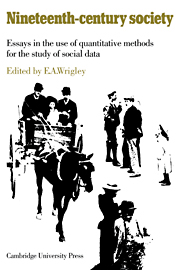Book contents
- Frontmatter
- Contributors
- Contents
- Introduction
- 1 The census, 1801–1891
- 2 The study of family structure
- 3 Sources of inaccuracy in the 1851 and 1861 censuses
- 4 Standard tabulation procedures for the census enumerators' books 1851–1891
- 5 Sampling in historical research
- 6 The use of information about occupation
- 7 The use of published census data in migration studies
- 8 Criminal statistics and their interpretation
- 9 The incidence of education in mid-century
- Notes
- Bibliography
- Index
9 - The incidence of education in mid-century
Published online by Cambridge University Press: 05 November 2011
- Frontmatter
- Contributors
- Contents
- Introduction
- 1 The census, 1801–1891
- 2 The study of family structure
- 3 Sources of inaccuracy in the 1851 and 1861 censuses
- 4 Standard tabulation procedures for the census enumerators' books 1851–1891
- 5 Sampling in historical research
- 6 The use of information about occupation
- 7 The use of published census data in migration studies
- 8 Criminal statistics and their interpretation
- 9 The incidence of education in mid-century
- Notes
- Bibliography
- Index
Summary
The standard histories of education are remarkably uninformative on the prevalence of education in nineteenth-century England, and particularly on its variation between different areas, social groups and age-groups. The textbooks either ignore these questions or confine themselves to summarising the very limited findings of the contemporary enquiries. This paucity probably owes something to the real or supposed inadequacies of the evidence, but more perhaps to the tendency for educational history to separate itself from general historical studies and remain the preserve of educationists whose interests lie primarily in the theory and methods of education or in the development of the public system of instruction. The latter preoccupation indeed gives a special perspective to the history of education in England. The period before 1870 is studied as the prelude to Forster's Act, and the specialists are rarely interested enough in the antediluvium itself to venture much beyond the proposition that before 1870 the mass of the population was grossly uneducated or at least undereducated.
The pattern of education before the 1870s deserves closer attention than this, for voluntary provision and attendance must have reflected social conditions far more than the subsequent system of board schools and compulsory attendance could do. Its obvious relevance to problems of literacy and social mobility provides further justification for studying the educational structure of the earlier period.
For these purposes the interest lies less in the provision of educational facilities, on which the standard histories have tended to concentrate, than in their utilisation.
- Type
- Chapter
- Information
- Nineteenth Century Society , pp. 397 - 410Publisher: Cambridge University PressPrint publication year: 1972
- 2
- Cited by



